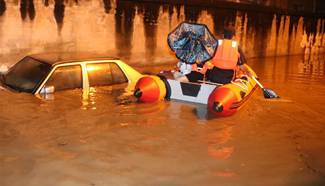(II) Main Composition of the BDS
The BDS is mainly comprised of three segments: space segment, ground segment and user segment.
- The space segment. The BDS space segment is a hybrid navigation constellation consisting of GEO, IGSO and MEO satellites.
- The ground segment. The BDS ground segment consists of various ground stations, including master control stations, time synchronization/uplink stations, and monitoring stations.
- The user segment. The BDS user segment consists of various kinds of BDS basic products, including chips, modules and antennae, as well as terminals, application systems and application services, which are compatible with other systems.
(III) Characteristics of the BDS
The BDS development follows a model of developing regional service capacities, then gradually extending the service globally. This practice has enriched the development models for navigation satellite systems worldwide.
The BDS possesses the following characteristics: First, its space segment is a hybrid constellation consisting of satellites in three kinds of orbits. In comparison with other navigation satellite systems, the BDS operates more satellites in high orbits to offer better anti-shielding capabilities, which is particularly observable in terms of performance in the low-latitude areas. Second, the BDS provides navigation signals of multiple frequencies, and is able to improve service accuracy by using combined multi-frequency signals. Third, the BDS integrates navigation and communication capabilities for the first time, and has five major functions - real-time navigation, rapid positioning, precise timing, location reporting and short message communication services.
(IV) Improvement of BDS Performance
To meet the increasing user demand, BDS technical research and development in the areas of satellites, atomic clocks and signals will be strengthened, and a new generation of navigation, positioning and timing technologies will be explored to improve service performance.
- Providing global services. China will launch new-generation navigation satellites, develop airborne atomic clocks with enhanced performance, further improve the performance and lifetime of satellites, and build more stable and reliable inter-satellite links. It will broadcast additional navigation signals, and enhance the compatibility and interoperability with other navigation satellite systems, so as to provide better services for global users.
- Strengthening service capabilities. China will establish a grounded test and validation bed to accomplish the full coverage of tests and validation for space and ground equipment; continue to build and improve satellite based and ground based augmentation systems to substantially enhance BDS service accuracy and reliability; optimize the technical system of location reporting and short message communication to expand user volume and service coverage.
- Maintaining spatio-temporal reference. The BDT is related to the Coordinated Universal Time, and the time bias information is broadcast in the navigation message. China will push forward the clock bias monitoring with other navigation satellite systems, and improve their compatibility and interoperability. It will develop a BDS-based worldwide location identification system, increase the interoperability between BDS coordinate frame and that of other navigation satellite systems, and constantly refine the reference frame.
III. Reliable and Safe Satellite Navigation Services
China is committed to ensuring the safe and reliable operation of the BDS by taking multiple measures, and to providing continuous, stable and reliable open services to users free of charge.
(I) Ensuring Safe and Reliable BDS Operations
- Improving the management mechanism on operation. Perfecting a normalized multi-party response mechanism for BDS space segment, ground segment and user segment. Continuously enhancing the capability of assurance to manage the operation of large-scale constellations.
- Establishing a GNSS monitoring and assessment network. Constructing an international GNSS Monitoring and Assessment System, actively implementing international cooperation, extensively exploiting international resources, carrying out monitoring and assessment of the constellation status, signal accuracy, signal quality and service performance of the BDS at every scale, and providing references for users' applications.
- Taking a redundant and backup approach. Adopting a satellite backup strategy both in-orbit and on-ground to reduce and avoid the effects of emergent in-orbit satellite fault affecting service performance. Redundant and backup design is adopted to enable ground facilities to eliminate weak links, and to enhance BDS reliability.
(II) Providing Open Services Free of Charge
Currently, B1I and B2I open service signals are being broadcast by the operating BDS-2 to provide open services to the Asia-Pacific region free of charge. The services cover an area extending 55 degrees North-55 degrees South and 55 degrees East-180 degrees East, with positioning accuracy less than 10 meters, velocity measurement accuracy less than 0.2 meter per second, and timing accuracy less than 50 nanoseconds.
(III) Disseminating BDS Information in a Timely Manner
- Publishing BDS documents related to open services and signals to provide inputs for global BDS product development efforts. The Interface Control Document of B1I and B2I signals has been published, which defines the interface specifications between the BDS-2 satellites and user terminals. It specifies the signal structures, basic characteristics, ranging codes, NAV messages and other contents. The Open Service Performance Standard has been published, which defines the service coverage area, accuracy, continuity, availability, and other performance indexes of the BDS-2. In the future, related documents will be updated and published in step with BDS construction and development.
- Establishing a multi-channel information dissemination mechanism. China holds news conferences when appropriate to disseminate important information about BDS development, and releases the latest news of the system in a timely manner through the official BDS website (www.beidou.gov.cn) from the aspects of system construction, operation, application, and international cooperation. It also issues notifications worldwide in advance before carrying out plans which might affect user services.
(IV) Protecting the Utilization of Radio-Navigation Satellite Frequency Spectrum
- Protecting the radio-navigation satellite frequency spectrum according to law. China protects the utilization of BDS frequency spectrum, and ensures the safety of BDS operation and BDS users pursuant to the national laws and regulations regarding the radio frequency spectrum.
- Firmly rejecting harmful interference. China prohibits the production, sale and use of illegal interference devices, investigates and punishes in accordance with the law any hostile interference actions which affect the system operations and services.











